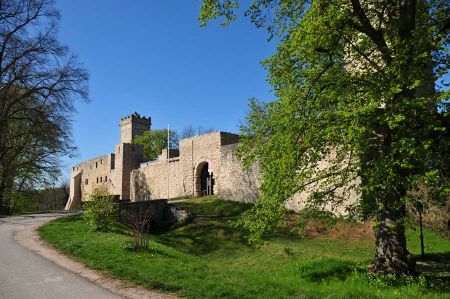The Eckartsburg on Via Regia - Route of Merchandisers
- Written by Portal Editor
The Eckartsburg with its 36-metre-high tower can be seen from afar, because it is located on the Finne, a high ridge on the state border of Saxony-Anhalt to Thuringia.
The margrave of Meißen, Ekkehard I, is considered to be the builder of the forerunner of today's castle complex, who is said to have mortgaged with Meissen in 985 and subsequently built the castle in the year 998 on Via Regia. Although there is no compelling evidence to support this idea, the castle has, nevertheless, become a symbol of the city.
The Via Regia ”or Royal Street was an important west-east trade and military route in the Holy Roman Empire and a pilgrimage route in the Middle Ages and early modern era. Despite the similarity in name it was not a 2000-year-old Roman road. It connected the Rhineland to Silesia via Frankfurt am Main and Leipzig.
Via Regia - trade and military route in the Holy Roman Empire
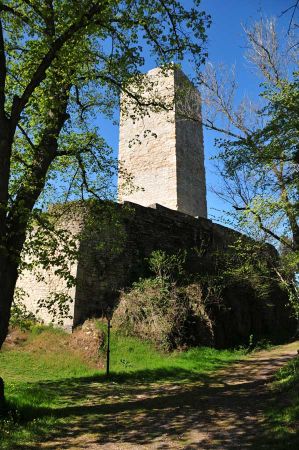 Via Regia “was originally more of a legal status road traffic in medieval. In the Holy Roman Empire of German Nations, it was the time, when trade routes were under the special protection of the royal central authority”. In the general sense, the term does not originally refer to a specific street, but rather to a type of street with special protective functions for the safety of commercial travellers by the authorities.
Via Regia “was originally more of a legal status road traffic in medieval. In the Holy Roman Empire of German Nations, it was the time, when trade routes were under the special protection of the royal central authority”. In the general sense, the term does not originally refer to a specific street, but rather to a type of street with special protective functions for the safety of commercial travellers by the authorities.
There were many such roads and military roads in the Holy Roman Empire, for example the Via Regia from Szczecin via Menzlin to Wismar, Lübeck and Hamburg, the "most important east-west road in the north" of the medieval West Slavic settlement area.
Most famous Via Regia from the Rhine to Silesia, this type of street name got the name of this particular street. Via Regia or Via Regina is also called the road along the western shore of Lake Como.
Back to the Eckartsburg castle complex
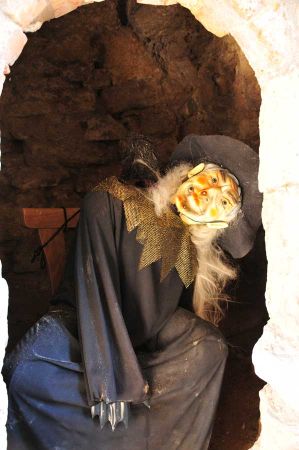 If the castle actually was founded by the Ekkehardiner, it fell back to the Reich in 1046 when there were no more families following. The Reichsburg complex remained until the Landgraves of Thuringia were vested with the rule. The first secure information about the existence of the castle is a document, which was issued in 1066 by King Henry IV in Eckartsberga. In 1074 the Eckartsburg was even mentioned directly.
If the castle actually was founded by the Ekkehardiner, it fell back to the Reich in 1046 when there were no more families following. The Reichsburg complex remained until the Landgraves of Thuringia were vested with the rule. The first secure information about the existence of the castle is a document, which was issued in 1066 by King Henry IV in Eckartsberga. In 1074 the Eckartsburg was even mentioned directly.
The castle consists of the main castle and the outer bailey; it is entered through an 8.2-meter-long archway. The archway has a niche as an apartment for the gatekeeper, which was also used as a prison. The main castle is accessible through a 10.4-meter-long and 2.8-meter-wide gate with three-meter-thick walls.
The preserved, 22-meter-high tower is based directly on the rock, has 2.50-meter-thick walls and served as a prison and torture tower.
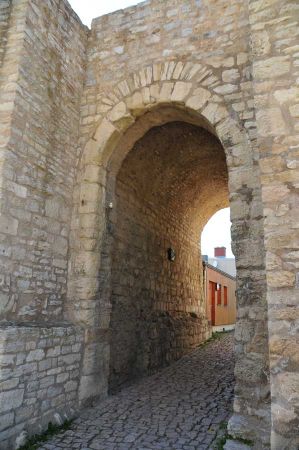 Inside the keep, the barrel vault has an opening by which the prisoners were released into the prison. The tower door is at a height of nine meters.
Inside the keep, the barrel vault has an opening by which the prisoners were released into the prison. The tower door is at a height of nine meters.
The other (large) tower is 36 meters high, can be climbed bar (view) and has five floors. It was used as a watchtower and as accommodation. The first floor is now filled with rubble. A diorama and a smaller museum are now housed on the other floors. "The wall thickness is 2.5 meters up to the third floor, then approx. 1.5 meters, so that there is a rampart of one meter."
The only surviving living quarters are located on the south side of the castle and are used as a restaurant and inn today with a wonderful beer garden in the castle garden. For the 1000th anniversary of the castle in 1998, the palace was rebuilt and is now used for cultural purposes. The Maiden Tower has windows and mechanics for defence.
Today's use as a beer garden and viewing platform
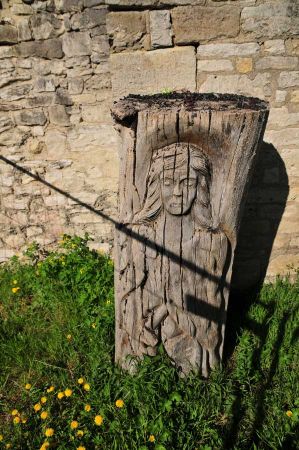 In the interior of the tower there is now a tin figure exhibition, which shows the course of the battle at Jena and Auerstedt as a diorama.
In the interior of the tower there is now a tin figure exhibition, which shows the course of the battle at Jena and Auerstedt as a diorama.
By the way: In the castle hall there is the original impeller of forester Karl Freiherr von Drais, which he developed in Karlsruhe in 1817. Drais, despite many affairs and strange actions, is still considered to be the real inventor of the bicycle.
Please read as well:
On the way to Eckartsburg - summer tobogga in Eckartsberga
Rigid sedge - this swamp plant contributes to silting up
-
 On the way to Eckartsburg in Eckartsberga
On the way to Eckartsburg in Eckartsberga
On the way to Eckartsburg in Eckartsberga
On the way to Eckartsburg in Eckartsberga
-
 On the way to Eckartsburg in Eckartsberga
On the way to Eckartsburg in Eckartsberga
On the way to Eckartsburg in Eckartsberga
On the way to Eckartsburg in Eckartsberga
-
 On the way to Eckartsburg in Eckartsberga
On the way to Eckartsburg in Eckartsberga
On the way to Eckartsburg in Eckartsberga
On the way to Eckartsburg in Eckartsberga
-
 On the way to Eckartsburg in Eckartsberga
On the way to Eckartsburg in Eckartsberga
On the way to Eckartsburg in Eckartsberga
On the way to Eckartsburg in Eckartsberga
-
 On the way to Eckartsburg in Eckartsberga
On the way to Eckartsburg in Eckartsberga
On the way to Eckartsburg in Eckartsberga
On the way to Eckartsburg in Eckartsberga
-
 On the way to Eckartsburg in Eckartsberga
On the way to Eckartsburg in Eckartsberga
On the way to Eckartsburg in Eckartsberga
On the way to Eckartsburg in Eckartsberga
-
 On the way to Eckartsburg in Eckartsberga
On the way to Eckartsburg in Eckartsberga
On the way to Eckartsburg in Eckartsberga
On the way to Eckartsburg in Eckartsberga
-
 On the way to Eckartsburg in Eckartsberga
On the way to Eckartsburg in Eckartsberga
On the way to Eckartsburg in Eckartsberga
On the way to Eckartsburg in Eckartsberga
-
 On the way to Eckartsburg in Eckartsberga
On the way to Eckartsburg in Eckartsberga
On the way to Eckartsburg in Eckartsberga
On the way to Eckartsburg in Eckartsberga
-
 On the way to Eckartsburg in Eckartsberga
On the way to Eckartsburg in Eckartsberga
On the way to Eckartsburg in Eckartsberga
On the way to Eckartsburg in Eckartsberga
-
 On the way to Eckartsburg in Eckartsberga
On the way to Eckartsburg in Eckartsberga
On the way to Eckartsburg in Eckartsberga
On the way to Eckartsburg in Eckartsberga
-
 On the way to Eckartsburg in Eckartsberga
On the way to Eckartsburg in Eckartsberga
On the way to Eckartsburg in Eckartsberga
On the way to Eckartsburg in Eckartsberga
-
 On the way to Eckartsburg in Eckartsberga
On the way to Eckartsburg in Eckartsberga
On the way to Eckartsburg in Eckartsberga
On the way to Eckartsburg in Eckartsberga
-
 On the way to Eckartsburg in Eckartsberga
On the way to Eckartsburg in Eckartsberga
On the way to Eckartsburg in Eckartsberga
On the way to Eckartsburg in Eckartsberga
-
 On the way to Eckartsburg in Eckartsberga
On the way to Eckartsburg in Eckartsberga
On the way to Eckartsburg in Eckartsberga
On the way to Eckartsburg in Eckartsberga
-
 On the way to Eckartsburg in Eckartsberga
On the way to Eckartsburg in Eckartsberga
On the way to Eckartsburg in Eckartsberga
On the way to Eckartsburg in Eckartsberga
-
 On the way to Eckartsburg in Eckartsberga
On the way to Eckartsburg in Eckartsberga
On the way to Eckartsburg in Eckartsberga
On the way to Eckartsburg in Eckartsberga
-
 On the way to Eckartsburg in Eckartsberga
On the way to Eckartsburg in Eckartsberga
On the way to Eckartsburg in Eckartsberga
On the way to Eckartsburg in Eckartsberga
-
 On the way to Eckartsburg in Eckartsberga
On the way to Eckartsburg in Eckartsberga
On the way to Eckartsburg in Eckartsberga
On the way to Eckartsburg in Eckartsberga
-
 On the way to Eckartsburg in Eckartsberga
On the way to Eckartsburg in Eckartsberga
On the way to Eckartsburg in Eckartsberga
On the way to Eckartsburg in Eckartsberga
-
 On the way to Eckartsburg in Eckartsberga
On the way to Eckartsburg in Eckartsberga
On the way to Eckartsburg in Eckartsberga
On the way to Eckartsburg in Eckartsberga
https://www.alaturka.info/en/germany/saxony-anhalt/5073-the-eckartsburg-on-via-regia-route-of-merchandisers?tmpl=component&print=1&layout=default#sigProId11a65512e2
